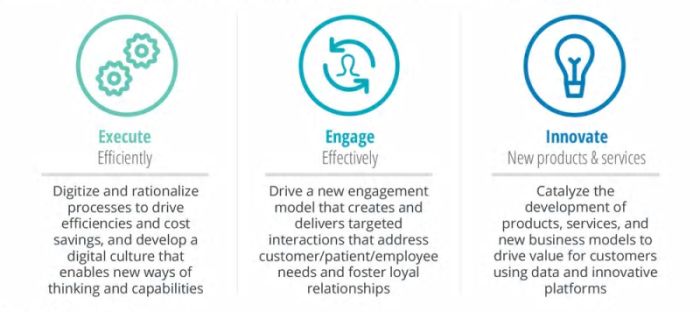Deloitte recently conducted a survey with the MIT Sloan Management Review to assess the digital maturity of companies across a wide variety of industries.1 Our colleagues in the US Center for Health Solutions analysed the responses from biopharma companies and published them in a separate report - Survey finds biopharma companies lag in digital transformation: It is time for a sea change in strategy.2 Headlining the report is the finding that only 20 per cent of biopharma respondents think their companies are digitally mature, compared to 30 per cent across all industries.3
This report and its findings caused me to reflect on our own work in this area. Each December we publish the latest report in our series Measuring the return from pharmaceutical innovation. Our 2017 report A new future for R&D? found the pharmaceutical industry continues to face an extremely challenging R&D environment; the cost to bring a drug to market has nearly doubled, while the projected peak sales per asset has nearly halved since we first published our report in 2010. Our report also analysed emerging digital technologies that have the potential to transform the productivity and efficiency of drug development and concluded that by embracing these emerging technologies the industry could create a more vibrant and sustainable future.
The potential of these digital technologies goes far beyond R&D though, with complete digital transformation of the industry viewed by many as a critical imperative to its future success. Consequently, many biopharma companies are experimenting with digital technologies, but an industry-wide move toward the types of consistent, sustained and bold changes required to take advantage of digital's new capabilities has yet to appear. This MIT research, in providing evidence of the slow pace of adoption, demonstrates just how far pharma has to go to optimise the use of digital technology.
A lack of a clear vision and leadership were cited as two of the main reasons biopharma is lagging behind other industries. Figure 1 shows the top three traits biopharma employees are looking for from their leaders, including creating an environment ripe for innovation, providing a vision and purpose that gives a clear level of direction, and empowering employees in a way that drives better execution. More than three-quarters (78 per cent) of biopharma respondents to the survey think their organisation needs to find new leadership to accomplish these goals.
Figure 1. Top three traits biopharma employees are looking for from their leaders

Source: Survey finds biopharma companies lag in digital transformation: It is time for a sea change in strategy
One strategy some biopharma companies are employing is recruiting new members of their leadership teams, typically as chief digital officers. Interestingly, some of these positions have been filled by individuals from outside the biopharma and tech industries, with companies tapping into industries such as retail and fashion to find the right expertise.4
With supportive leadership, a clear overall strategy and a culture of collaboration and experimentation in place, the report discussed three opportunities for biopharma to take advantage of digital technologies and transform their businesses (see Figure 2), citing specific examples for each opportunity.
Figure 2. Digital transformation offers biopharma companies opportunities to execute efficiently, engage effectively and innovate new products and services

Source: Survey finds biopharma companies lag in digital transformation: It is time for a sea change in strategy
To execute efficiently:
- one biopharma is focusing on its supply chain, experimenting with virtual reality in its manufacturing operations
- another is streamlining marketing efforts, cutting 20 per cent of its marketing base costs by setting up a global marketing system
- a health care company is utilising bots to automate their hiring processes, acquiring talent more efficiently.
To engage effectively biopharma companies are:
- creating a platform for customer experience, such as Deloitte's PatientConnect, which supports digital therapy, helps improve patient outcomes and helps health care providers coordinate to manage patient care
- connecting patients, biopharma, caregivers, health care providers and other stakeholders through the use of Deloitte's ConvergeHealth, which helps biopharma companies build partnerships with advocacy groups and providers to enhance the experience of patients with complex, chronic and terminal diseases
- optimising the content provided to health care practitioners by building a self-service portal for over 30,000 practitioners across Europe to access marketing and sales content across a variety of media.
To innovate products and services biopharma companies are looking to improve the return on R&D by shortening drug discovery or lowering R&D costs by:
- expediting recruitment and diversifying participants by utilising a technology platform with a built-in e-consent module
- using new data sources that utilise blockchain to develop insights based on personal data that users are willing to share.
Accomplishing digital transformation will not be an easy task for most biopharma companies, but it can be accomplished by first determining and articulating their ambition. The final three steps then needed are:
- organise, operate and behave in new digital ways
- design the solution and data architecture
- deliver and scale the ambition.
If biopharma companies can overcome barriers to success and accomplish these steps, they will be better placed to adapt and succeed in a rapidly changing market. We are exploring these themes in more detail as we develop our next Measuring the return from pharmaceutical innovation 2018 report, which will be published in December.
Survey methodology: In autumn 2017, MIT Sloan Management Review (MIT SMR) and Deloitte surveyed global executives, business leaders and analysts across 28 industries and 123 countries to understand how digital is impacting organisational strategy, culture, leadership and talent. The subsequent US Center for Health Solutions report analysed data collected from 68 biopharma respondents from a distribution of companies of varying sizes (ranging from less than US$1 billion to more than US$20 billion). More than two-thirds of respondents were from outside the United States.
Footnotes
The content of this article is intended to provide a general guide to the subject matter. Specialist advice should be sought about your specific circumstances.
